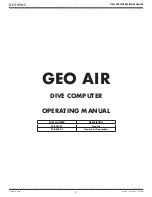
Copyright © Sigicom AB 2021
2
IMPORTANT SAFETY INSTRUCTIONS
– read this before use
Operating conditions and limitations:
•
The C22 shall not be submerged.
•
Safe operating temperature range is -30 to +50 ºC
(-22 to +122 ºF).
•
This instrument includes built-in radio transmitters and
antennas. It should be installed away from the operator or third-
party persons to be safe; a recommended minimum distance is
1 m (3 ft.).
•
Before installing the instrument, make sure there are no
restrictions of the use of radio transmitters at the intended site.
•
Do not use the instrument in presence of flammable fumes or
gases, or in explosive atmospheres.
Li-Ion batteries:
•
Only use batteries and power supplies provided or recommended by
Sigicom, see chapter
•
Do not use C22 batteries in other products than applicable Sigicom
products.
•
A power source connected to the C22 must not be able to supply more
than 20V and 3A. A solar panel with maximum 25W power and with an
open-circuit voltage of 22V is allowed.
•
Replacement and other handling of the batteries shall only be executed
by persons who have carefully read the instructions in this manual.
•
Never keep the batteries at temperatures above 50ºC (122ºF).
•
Transportation of Li-Ion batteries by aircraft is regulated by UN and
IATA. See Appendix B - Appendix D.
•
Transportation by road or railway is exempt from dangerous goods
transportation regulations. Care should still be taken with handling and
packaging to avoid severe injury.
•
If damaged, the batteries should be individually embedded into sand in a
sturdy plastic drum container during transport. It is also recommended
to affix a “Lithium Ion” label with an additional text: ‘Damaged
batteries’ on the package.
A worn-out battery, a battery with cracks or with signs of swelling or
leakage, shall be replaced immediately.
Note! Damaged or worn-out batteries are prohibited in air freight.
•
Never incinerate, disassemble or expose the batteries in water.



































